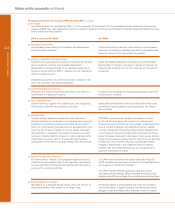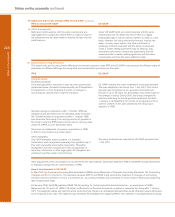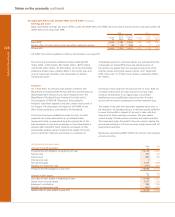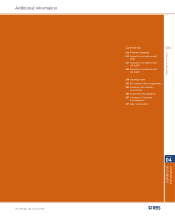RBS 2005 Annual Report Download - page 227
Download and view the complete annual report
Please find page 227 of the 2005 RBS annual report below. You can navigate through the pages in the report by either clicking on the pages listed below, or by using the keyword search tool below to find specific information within the annual report.
section
03
Financial
statements
225
Notes on the accounts
Annual Report and Accounts 2005
IFRS or relevant UK GAAP
(h) Securities
The Group’s debt and equity securities are classified as being
held as investment securities or for trading purposes. Investment
securities are stated at cost less provision for any permanent
diminution in value. Premiums and discounts on dated debt
securities are amortised to interest income over the period to
maturity. Securities held for trading purposes are carried at fair
value with changes in fair value recognised in profit or loss.
(i) Derivatives and hedging activities
Non-trading derivatives are entered into by the Group to hedge
exposures arising from transactions entered into in the normal
course of banking activities. They are recognised in the accounts
in accordance with the accounting treatment of the underlying
transaction or transactions being hedged. To be classified as non-
trading, a derivative must match or eliminate the risk inherent in
the hedged item from potential movements in interest rates,
exchange rates and market values. In addition, there must be a
demonstrable link to an underlying transaction, pool of transactions
or specified future transaction or transactions. Specified future
transactions must be reasonably certain to arise for the derivative
to be accounted for as a hedge. In the event that a non-trading
derivative transaction is terminated or ceases to be an effective
hedge, the derivative is remeasured at fair value and any resulting
profit or loss amortised over the remaining life of the underlying
transaction or transactions being hedged. If a hedged item is
derecognised, or a specified future transaction is no longer likely
to occur, the related non-trading derivative is remeasured at fair
value and the resulting profit or loss taken to the income statement.
Monetary assets denominated in a foreign currency are
retranslated at closing rates with exchange differences taken to
profit or loss. Equity shares financed by foreign currency
borrowings are retranslated at closing rates with exchange
differences taken to reserves along with differences on the
related borrowings.
Embedded derivatives are not bifurcated from the host contract.
(j) Consolidation
All entities controlled by the Group are consolidated together
with special purpose entities (SPEs) where the substance of the
relationship between the reporting entity and the SPE indicates
that it is controlled by the reporting entity.
US GAAP
Investment securities held by the Group’s private equity business
are considered to be held by investment companies and
carried at fair value, with changes in fair value being reflected in
net income. The Group’s other investment debt securities and
marketable investment equity shares are classified as available-
for-sale securities and measured at fair value with unrealised
gains and losses reported in a separate component of equity,
except when the unrealised loss is considered other-than-
temporary in which case the loss is included in net income.
The Group recognises an other-than-temporary impairment on an
available-for-sale equity share when its carrying value has
exceeded its market value for a period of more than twelve months.
The Group has not made changes in its use of non-trading
derivatives to meet the hedge criteria in SFAS 133 ‘Accounting
for Derivative Instruments and Hedging Activities’. For US
GAAP purposes, its portfolio of non-trading derivatives is
remeasured to fair value and changes in fair value reflected in
net income.
SFAS 133 does not permit a non-derivative financial instrument
to be designated as the hedging instrument in a fair value hedge
of the foreign exchange exposure of available-for-sale securities.
SFAS 133 requires derivatives embedded in other financial
instruments to be accounted for on a stand-alone basis if they
have economic characteristics and risks that differ from those
of the host instrument.
US GAAP requires consolidation by the primary beneficiary of
a variable interest entity (VIE). An enterprise is the primary
beneficiary of a VIE if it will absorb a majority of the entity’s
expected losses, receive a majority of the entity's expected
residual returns, or both. In accordance with the provisions of
FIN46R, trust preferred securities issued by subsidiaries are in
effect re-classified from minority interests to liabilities.
Certain trusts and partnerships that are subsidiaries under
IFRS are not consolidated under US GAAP because the Group
is not their primary beneficiary. As a result securities issued by
them are reclassified from minority interests to subordinated
liabilities.
























